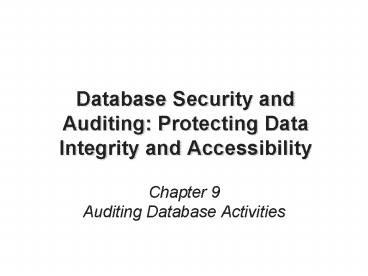Database Security and Auditing: Protecting Data Integrity and Accessibility - PowerPoint PPT Presentation
1 / 26
Title:
Database Security and Auditing: Protecting Data Integrity and Accessibility
Description:
Two types of activities based on the type of SQL command statement used: ... Use a SQL-based AUDIT command. Verify auditing is on: Check the AUDIT_TRAIL parameter ... – PowerPoint PPT presentation
Number of Views:108
Avg rating:3.0/5.0
Title: Database Security and Auditing: Protecting Data Integrity and Accessibility
1
Database Security and Auditing Protecting Data
Integrity and Accessibility
- Chapter 9
- Auditing Database Activities
2
Objectives
- Use Oracle database activities
- Learn how to create DLL triggers with Oracle
- Audit database activities using Oracle
3
Using Oracle Database Activities
- Several types of activities
- Application activities SQL statements issued
against application tables - Administration activities commands issued for
maintenance and administrative purposes - Database events events that occur when a
specific activity occurs
4
Auditing Database Activities with Oracle
- Oracle provides mechanisms for auditing all
- Who creates or modifies the structure
- Who is granting privileges to whom
- Two types of activities based on the type of SQL
command statement used - Defined by DDL (Data Definition Language)
- Defined by DCL (Data Control Language)
5
Auditing DDL Activities
- Use a SQL-based AUDIT command
- Verify auditing is on
- Check the AUDIT_TRAIL parameter
- Values
- DB
- DB_EXTENDED
- OS
- NONE
6
Auditing DDL Activities (continued)
7
DDL Activities Example 1
- Steps
- Use any user other than SYS or SYSTEM to create a
table - Add three rows into the table
- Log on as SYSTEM or SYS to enable auditing For
ALTER and DELETE - Log in as DBSEC
- Delete a row
- Modify the structure of the table
8
DDL Activities Example 1 (continued)
- Steps (continued)
- Check the audit records
- Log in as SYSTEM and view the DBA_AUDIT_TRAIL
table - Turn off the auditing option
- Check the content of the DBA_AUDIT_OBJECT to see
auditing metadata
9
DDL Activities Example 1 (continued)
10
DDL Activities Example 1 (continued)
11
DDL Activities Example 2
- Steps
- Log in as SYSTEM or SYS to enable auditing for
the TABLE statement ALTER, CREATE, and DROP
TABLE statements - Log on as DBSEC and create a table, then drop the
table - Log on as SYSTEM view the content of
DBA_AUDIT_TRAIL - Turn off auditing for the TABLE statement
12
DCL Activities Example
- Steps
- Log on as SYSTEM or SYS and issue an AUDIT
statement - Log on as DBSEC and grant SELECT and UPDATE to
SYSTEM - Log on as SYSTEM and display the contents of
DBA_AUDIT_TRAIL - Review audit data dictionary
13
DCL Activities Example (continued)
14
Example of Auditing User Activities
- Steps
- Log on as SYSTEM or SYS, to issue an audit
statement - Log on as DBA and create a temporary table
- Go back to SYSTEM to view the contents of
DBA_AUDIT_TRAIL
15
Audit Trail File Destination
- Steps
- Modify the initialization parameter file,
INIT.ORA set parameter AUDIT_TRAIL to the value
OS - Create a folder/directory
- Set AUDIT_FILE_DEST to the new directory
- Shut down and restart the database
- Connect as DBA
16
Oracle Alert Log
- Audits database activities
- Errors
- Errors related to physical structure are recorded
in the Alert log - Monitor errors every five to ten minutes can be
done using a Windows or UNIX script - Syntactical errors are not recorded
- Startup and shutdown
- Date and time of each occurrence
17
Oracle Alert Log (continued)
18
Oracle Alert Log (continued)
- Database activities (continued)
- Modified initialization parameters, each time a
database is started - Checkpoints configure Oracle to record
checkpoint time - Archiving view the timing for all redo log
sequences, as well as archiving times - Physical database changes
19
Oracle Alert Log (continued)
20
Creating DDL Triggers with Oracle
- Audit program provides
- Audit trail for all activities
- Opportunity for using process controls
- Database activities statements (in addition to
DML) - Data Definition Language (DDL)
- Data Control Language
- Database events
- SQL statements audit trail
21
Creating DDL Triggers with Oracle (continued)
- Use CREATE TRIGGER
- DDL statements
- Database events
22
Example of LOGON and LOGOFF Database Events
- Steps
- Log on as SYSTEM
- Create the APP_AUDIT_LOGINS table
- Create two triggers
- One that fires after the logon event
- One that fires before the logoff event
- Log on as DBA disconnect after a few minutes
- Log on as SYSTEM to check the auditing table
23
DDL Event Example
- Steps
- Log on as SYSTEM
- Create a trigger that fires before an ALTER
statement is completed - Log on as DBA and alter a table
- Pseudocolumns
- ora_dict_obj_name
- ora_dict_obj_owner
- ora_sysevent
24
Auditing Code with Oracle
- Steps
- Log on as DBA
- Create an auditing table
- Create a table and populate it with two records
- Create a trigger to track code
- Update the new table
- Look at the contents of the APP_AUDIT_SQLS table
25
Summary
- Activities types
- Application activities
- Administration activities
- Database events
- Oracle triggers provide a way to create an audit
trail - Auditable Oracle database activities logon,
logoff, startup and shutdown
26
Summary (continued)
- Oracle provides the SQL AUDIT command
initialization parameter AUDIT_TRAIL - NOAUDIT used to stop auditing
- DBA_AUDIT_TRAIL data dictionary view
- Oracle Alert Log
- Database errors
- Modified initialization parameters
- Checkpoints































